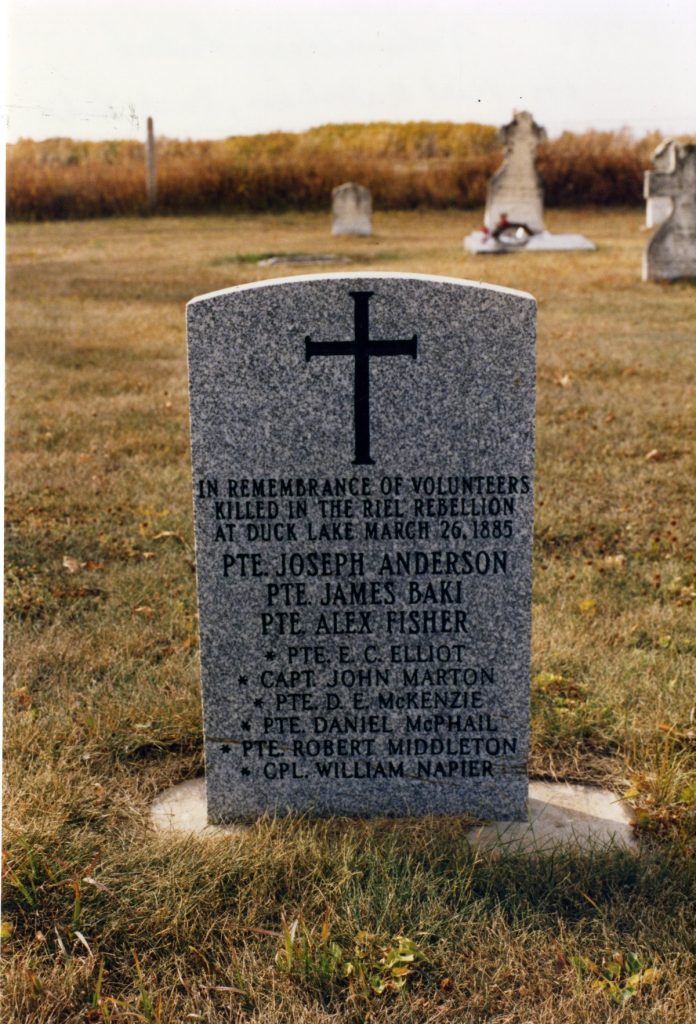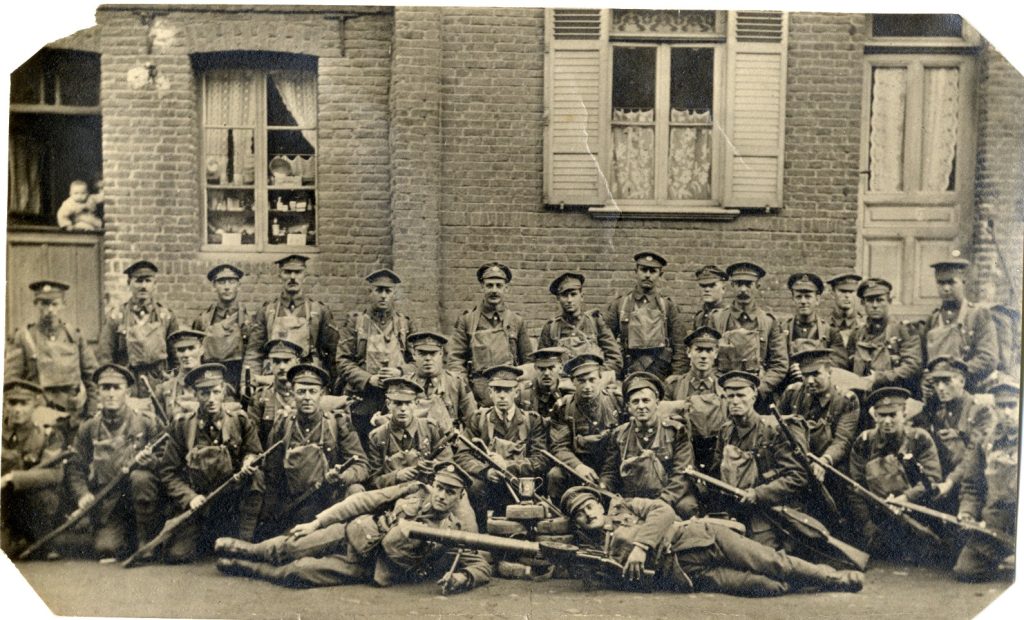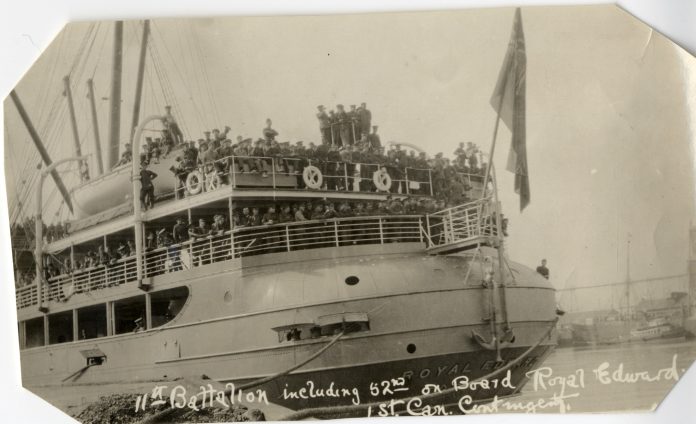I recently received a telephone call regarding an upcoming anniversary of the Prince Albert Volunteers. The Canadian Forces are anxious to commemorate the anniversary and, at the same time, to rectify what is considered to be an inaccuracy with respect to a memorial headstone which was erected in the graveyard surrounding St. Mary’s Anglican church.
As part of my research I discovered the following from the book The History of the Northwest Rebellion of 1885, written by Charles Pelham Mulvaney, A.M., M.D., published by S.B. Hovey & Co., 10 King Street East, Toronto, Ontario in 1885.
“On Tuesday, at 2:00 p.m., the funeral procession started for the Church of England cemetery, where it was thought best to lay the nine together in one common grave. The Prince Albert band led the way playing a funeral march. Then followed the volunteers, a body of police, and the ministers of the town. Next came the coffins, the mourners, and the general public. The Bishop and two of his clergy read the ordinary burial service. There was no sermon nor address, nor allusion to the peculiar circumstances. To some it seemed a pity that the order of the Church should be so rigid as to prevent any more honour being done to these brave men brought in from the field of battle, than would be shown at the burial of a newborn child. The Bishop of Saskatchewan and the Presbyterian minister, however, both preached funeral sermons appropriate to the circumstances on the following Sabbath.”
The headstone, which was erected at some point after 1962, commemorates the nine members of the Prince Albert Volunteers who were killed in March 1885 near Duck Lake. Of major concern is that the wording on the headstone refers to the Riel Rebellion. The Canadian Forces wish to have a replacement headstone referring to the Volunteers as having been killed during the Resistance. Of secondary importance is the fact that, although all nine men were interred at St. Mary’s, three were later exhumed and re-interred in Prince Albert’s South Hill Cemetery, while a fourth was exhumed and re-interred “down east”.
In researching the required changes regarding the headstone, I also discovered that the names of two of the remaining five men had been mis-spelled.

Having initiated the research for this project, I was led to uncovering some additional history about Prince Albert’s military history.
The earliest militia units in Prince Albert consisted of three infantry companies, two of which were mounted. Although organised in October 1879 (the year that the North West Territories was incorporated in the territorial limits of Military District No. 10), these companies did not receive official status until the following year. Dating from January 16th, 1880, they were: No. 1 Company, Prince Albert Mounted Rifles under Commanding Officer Captain C. F. Young (formerly a Captain in Her Majesty’s 50th Foot); No. 2 Company, Prince Albert Mounted Rifles under Commanding Officer Captain H.S. Moore; and Prince Albert Infantry Company under Captain Thomas McKay.
Thomas McKay later became Prince Albert’s first mayor, and still later farmed in the Royal district. Captain Moore brought the first grist mill to Prince Albert and, as a result of a leg wound suffered during the Resistance, had to have the leg amputated. He later returned to his homeland of Ireland where both he and his wife died. Captain Young farmed east of Prince Albert and, based upon copies of letters which the grandson of Colonel Sproat has shared with the Bill Smiley Archives, I believe he later moved in the early to mid-1880s further up river to the area of modern-day Edmonton.
Each of the three companies consisted of three officers and 42 non-commissioned officers and men. They were required to drill a minimum of six days and a maximum of twelve days each year. Daily drills were of three hours duration. Each man received fifty cents a day, with those on horseback receiving an additional seventy-five cents a day.

Little is known about the activities of these units. Although they were selected to drill in 1881, it would appear that no returns were received. The Deputy Adjutant-General, in his report on the corps for the year, which also included a company at each of Battleford and Duck Lake, stated: “all the corps in the North West Territories have been selected for drill this year, but not having received any official communication from them on the subject, I am unable to state what progress they are making. I learn, however, from private sources that some, if not all of them, have been performing more or less drills this season.”
The following year, he reported: “the North West Corps consisting of three Mounted Infantry and two Infantry Companies have never been inspected since their first organization in October, 1879. In consequence of not yet having received any uniforms, they were relieved from drill this year, by order of the Adjutant-General, dated August 10. In reference to these corps I may state that it is hardly to be expected that they will give up much of their valuable time and supply their own horses for drilling purposes, or even regard themselves in the light of a properly organized body of militia, until after they have been properly furnished with uniforms of some pattern or denomination.”
Local sources indicate that the Prince Albert Corps did actually drill regularly, but saw no action until March 20th, 1885. It was on that day that Gentleman Joe McKay rode into Prince Albert with an urgent message from Major L.N. Crozier, the officer in charge of the North West Mounted Police at Fort Carlton. The Walters & Baker store at Batoche had been raided. A meeting shortly ensued and, within a few hours of McKay’s arrival, 80 men were sworn in and, armed with short Snider rifles, journeyed along the river trail to Fort Carlton to reinforce the police at Fort Carlton.
On March 26th, Major Crozier with 20 North West Mounted Police and 80 Volunteers left the fort for Duck Lake in order to commandeer any available supplies. They managed to get within three miles of Duck Lake before realising that they had ridden into a well-planned ambush. Crozier, with his interpreter McKay, attempted to negotiate with three of those who were opposing them. Although Crozier was under orders to avoid open bloodshed, the confrontation escalated and, on Crozier’s command, McKay shot one of their opponents. Thus, Canada’s first and only civil war began.
Losing nine Volunteers in the fierce forty-five-minute battle resulted in the Prince Albert Volunteers being awarded their first battle honours. Surviving members of the Volunteers received the North West Canada medal, and a grant of 320 acres (130 ha) of land, or scrip of $80 in lieu.
The next action seen by the local Volunteers occurred when members participated in the South African (Boer) War between 1899 and 1902. I recall a local businessman telling me, when I was just a child, that his first memory as an infant was of the celebration when some of our local soldiers returned from that conflict.
Additional action was seen by local men during the Great War. As a result, battle honours were awarded to the Prince Albert unit in 1929 for their participation in Mont Sorrel, Somme 1916, Arras 1917, 1918, Hill 70, Ypres 1917, Amiens, Hindenburg Line, and Pursuit to Mons 1918. The colours of the Regiment carry the honours for Somme 1916, Arras 1917, 1918, Hill 70, Ypres 1917, Amiens, Hindenburg Line, and Pursuit to Mons 1918.
At the end of the Great War, over 2,000 men from Prince Albert and area had seen service overseas.
Throughout the years, from 1880 to 1955, the Prince Albert Volunteers were part of a number of different armed forces units, including the Regina Rifles and the Saskatoon Light Infantry, as well as being affiliated with the Oxfordshire and Buckinghamshire Light Infantry. Efforts were always made to ensure that the denomination of Prince Albert Volunteers was continued, either as a Regiment or a Battalion. The Volunteers are currently a part of the North Saskatchewan Regiment.
fgpayton@sasktel.net


